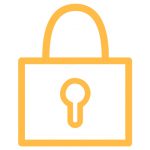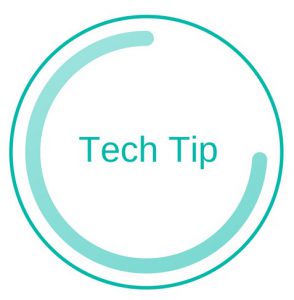Tech Tip: How to create and remember a secure password
You have probably heard the news that hackers have stolen around two million usernames and passwords. The hacks were from 93,000 websites, including Google, Facebook, Twitter, Yahoo and LinkedIn.
Hackers are usually interested in accessing a user’s financial and other accounts using the password they’ve stolen. Some websites have already notified affected users and asked them to change their passwords.
Experts are recommending that you:
- Pay attention to your bank and credit account statements in the next few months since hackers often wait to act.
- If your passwords for sites involving financial transactions are the same as your social and email passwords, change them!
- Never use the same password for more than one account. That way, if a hacker gets into, say, your Facebook account, they won’t be able to access any others.
- The most common hacked password was 123456. Never use obvious, easy to remember sequences for your password!
 What’s Safe – and What’s Unsafe
What’s Safe – and What’s Unsafe
Passwords may seem like an annoyance blocking you from what you want to do online, but of course they help keep your personal information safe from criminals who are up to no good. Think of a strong online password as a burglar-proof, fire-proof, triple-locked safe for your personal documents. It may be unlikely that you’ll be burglarized; but you’d rather be safe than sorry.
So, although you might be tempted to go with an easy-to-remember password like “12345” or even the word “password,” it’s a good idea to come up with something that’s harder to remember. Simple passwords like “12345” aren’t only simple for you – they’re also the easiest ones for someone to guess.
The same goes for using a single password for all your accounts: easy – but unsafe. If one account is compromised because someone figures out the password, then all your accounts could potentially be compromised. For your own safety, every account should have its own unique password.
Now let’s move on to what constitutes a strong password and how to create one for each of your accounts. At the end, I’ll give you some tips on how to remember all your new (or old) passwords.
 Strong Password Do’s and Don’ts
Strong Password Do’s and Don’ts
Here are some tips for making your online password secure. It should:
- Have at least eight characters long, preferably more
- Include a combination of letters, numbers and punctuation (like *or $ or #)
- Include a combination of uppercase and lowercase letters
- Not be an actual word
- Not use your real name, username or personal information, such as your birthday, license plate number or address.
 How to Create a Strong Password: Method 1
How to Create a Strong Password: Method 1
Start with something that is memorable to you: a phrase, a date or a hobby. For demonstration purposes, I’m going to use the phrase “Cooking is fun.”
Next, I’m going to do the following:
- Replace each “a” with @
- Replace each “s” with $
- Replace each space with %
- Replace ‘o’ with 0 (the number zero)
- Replace each “i” with !
“Cooking is fun” becomes C00k!ng%!s%fun
 How to Create a Strong Password: Method 2
How to Create a Strong Password: Method 2
Think of a group of names that are related to each other: your children’s names, the names of your pets, or the names of all your siblings.
For demonstration purposes, let’s say my siblings are named Jessica, Jenny and John.
Combine the first couple of letters from each to form one word. It may look like gibberish to someone else, but it’s meaningful to you.
“Jessica Jenny John Betsy” becomes JeJeJoBe
 How to Create a Strong Password: Method 3
How to Create a Strong Password: Method 3
If it seems too confusing to create a password using the methods above, you can also have a use a password created by a password generator website. These websites use computer algorithms to create random passwords and they don’t send or store the passwords.
Here’s how to use a password generator:
Go to strongpasswordgenerator.com or random.org/passwords
Follow the instructions to select the number of characters you want your password to be.
After you click the “get password” or “generate strong password” button, you will be given a safe, strong password you can use.
 Remembering Your Password
Remembering Your Password
By now, hopefully you have a few strong passwords. The tricky part is remembering them so you can actually access your accounts.
Some people will write their passwords on a Post-it note and stick it to their computer monitor, under their mouse pad or under their desk. This is not a safe method.
If you locked your valuables in a heavy-duty safe, would you write the combination on a Post-it note and stick it to the safe? Probably not! It doesn’t matter how strong the safe is if you give away the combination.
It’s OK to write down your passwords to remember them, but make sure you hide the paper well. Here are a few places you could write down your password in case you forget it:
- In a cookbook on the page of your favorite recipe
- On the page of your favorite book
- On the back of a picture
- On a piece of paper in your wallet
- On a piece of paper that you lock in a safe
Don’t email your passwords to yourself; if hackers got into your email account, they would get access to all your accounts. And don’t keep your passwords on a document on your computer’s hard drive; that would be a little bit like putting them on a Post-it on your computer screen.
Ready?
Go make safe passwords!
Have a question you would like to see answered here? Send us a private message by clicking here.
About the Author: David Siegel serves as the Director of Information Technology at Eliza Bryant Village. In his role, he is responsible for the management, strategy and execution of IT infrastructure for an organization. For more than 10 years, Mr. Siegel has been charged with managing the infrastructure oversight of all technical operations. He serves as a hands-on professional who enjoys rolling up his sleeves and working with the team to achieve goals, meet quotas, eliminate security risks and increase overall safety and satisfaction.


